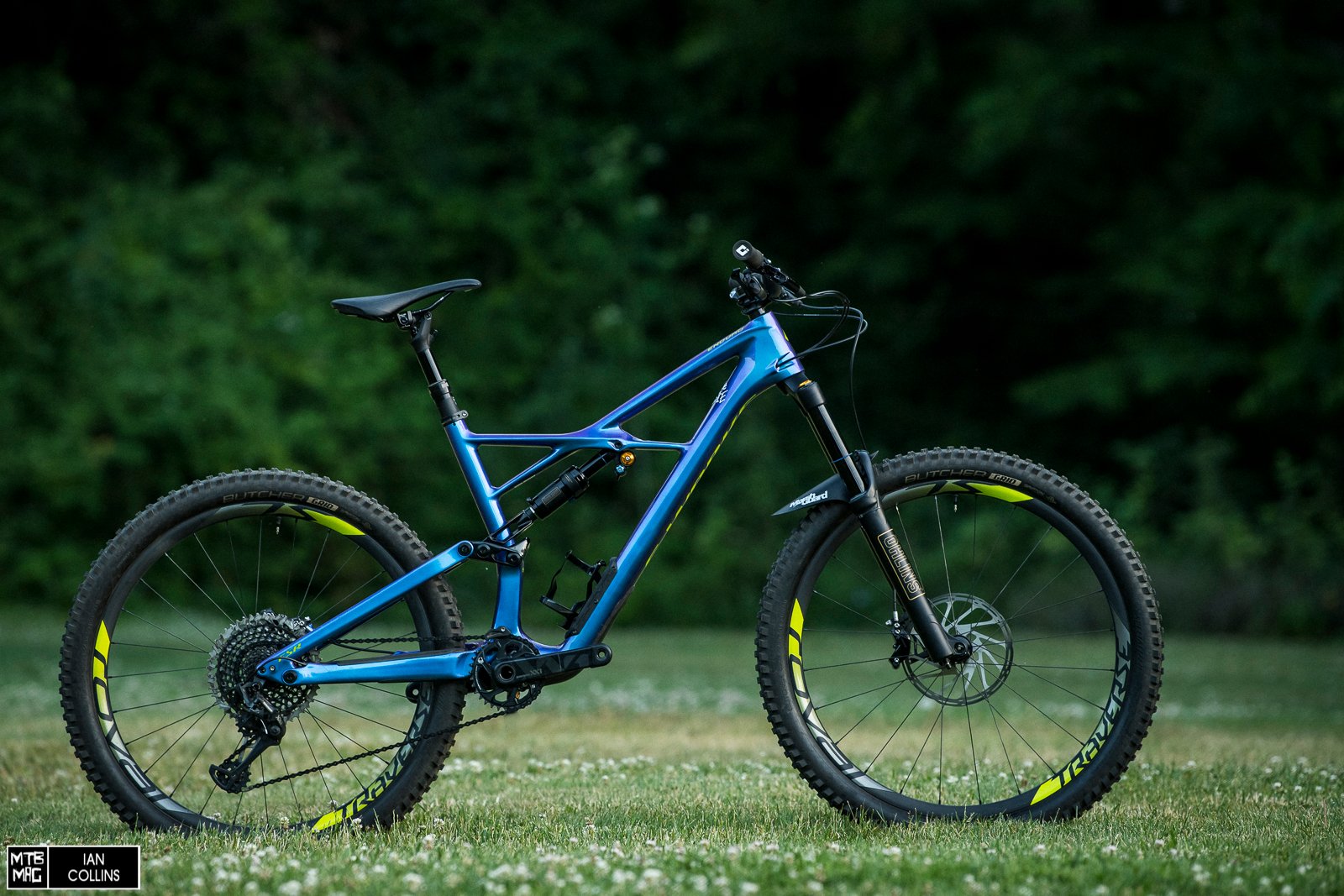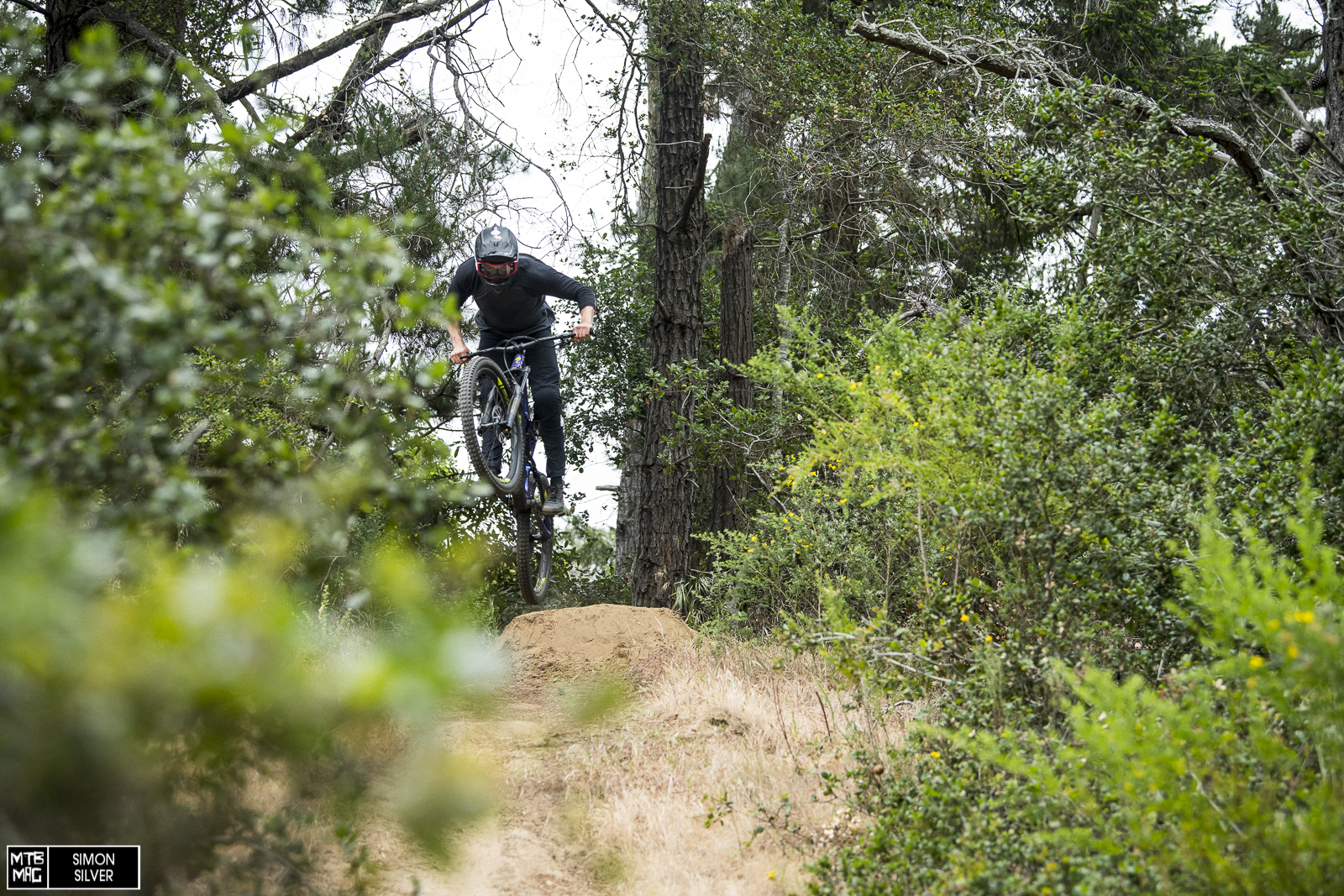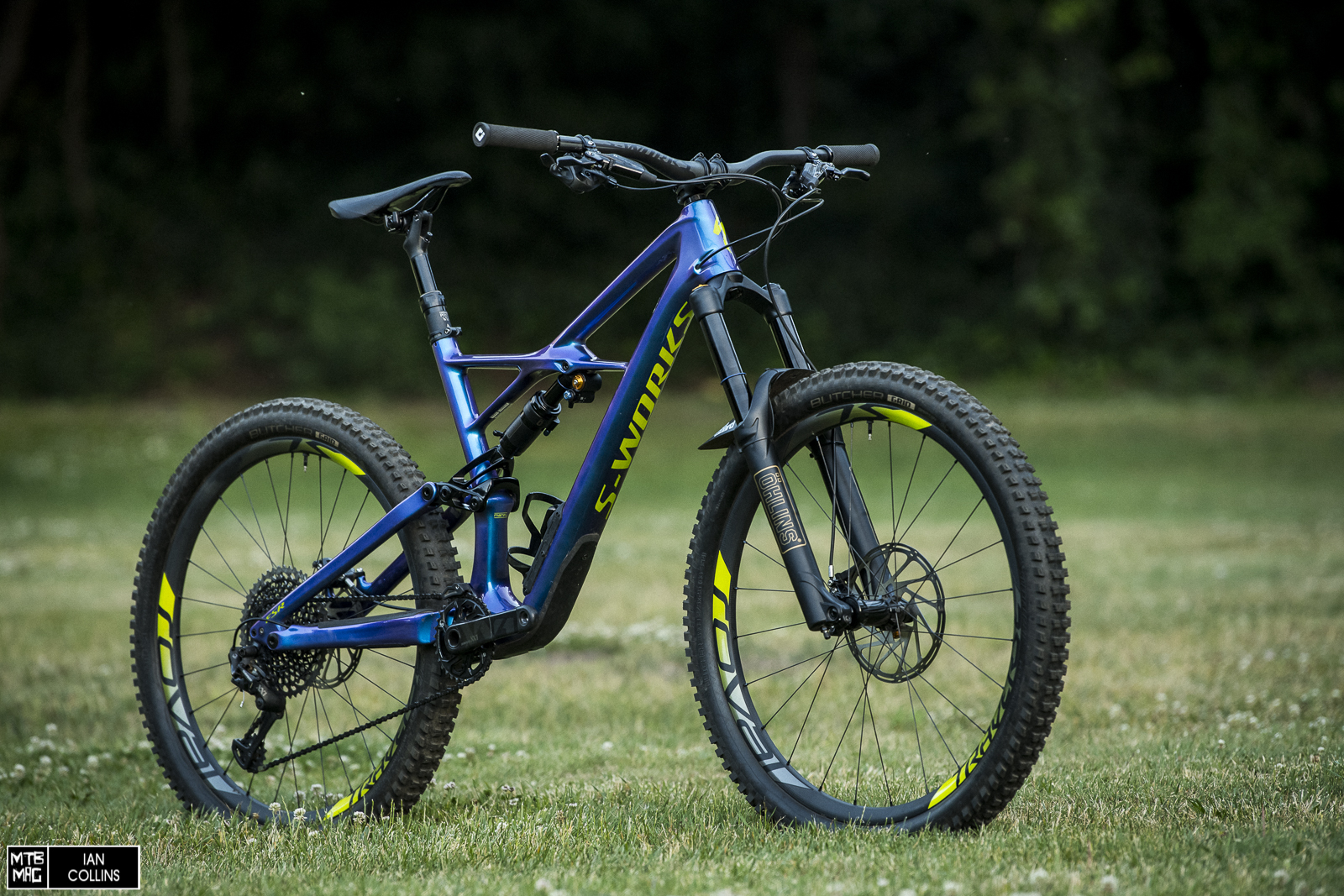For the last few months one of the bikes that I’ve been bouncing around on is a 27.5″ wheeled Specialized S-Works Enduro – the California brand’s flagship offering. I wrote a piece comparing it with its 2017 counterpart, and overall, I think this 2018 version is much improved, largely due to its geometry getting with the times…more specifically because of the longer reach. Anyhow, most of the other differences aren’t quite as glaring, and are more spec related than anything, but I’ll be going over them below as you read on.

For some years now, the Enduro has been the model in the Specialized lineup which represents about as much bike as you can get while still maintaining an ability to get back up the hill. In this segment, bikes continue to get increasingly longer, lower and slacker while still managing to get the ascending part of the job done (although sometimes, begrudgingly). Steeper seat angles, lighter weights and improved kinematics all deserve the tip of the hat as being responsible for the constantly improving climbing attributes of such long travel bikes. Anyhow, this particular medium wheeled whip has 170mm of travel front and rear and is built for a thrashing, no matter if it’s local laps, shuttles or in the bike park. Here’s how it treated us…
Details
- Carbon fiber front and rear triangles
- 170mm front and rear travel
- SWAT downtube storage
- FSR suspension with V2 Flip Chip link
- Sleeved, internal cable/hose routing
- Boost hub spacing front and rear
- Imperial shock spacing (216mm X 57mm)
- Threaded bottom bracket
- $8,500
- 29 pounds 2 ounces (no pedals or tubes, on our scale)
- Four sizes: S, M, L (tested), XL
- Two colors: Black and Blue (shown)

Cockpit – Up front, the Enduro is fitted with an in house S-Works DH Carbon handlebar. It’s a full 800mm wide with a 27mm rise and a 31.8mm bulge. I’ve ridden this bar before and it’s on trail feel is stellar. It’s mated to the Syntace Megaforce 2 stem which has a 6º rise and a 40mm length. The Sip Grips that comes stock on the bike are the only part on the entire bike that got swapped out and are not pictured here.
Out back, Specialized outfit the new Enduros with their new WU Command post in an oversized 34.9mm diameter. It utilizes a secondary cartridge and a hinged top section to allow the saddle to tilt upward as you lower it, for a better position on the descents. Unfortunately the post has only 115mm of actual shaft travel. Measuring the saddle from the back, it clocks in at 150mm though. Lastly, the Henge Expert saddle features titanium rails and a 143mm width.

Features – SWAT (Storage Water Air Tools) is a big part of the story with the Enduro. A removable door sits on the downtube with the bottle cage attached to it. We’ve fit the following into a downtube in one ride before: pump, spare tube, gel, bar, lightweight jacket and a burrito. Bottom line: it’s a huge selling point. This year, the headtube area features SWAT with a headlock style tensioner that doubles as a chain tool which houses a spare link, as well as quick access for a multi tool.
Other notable frame features include unified hardware, all of which use the same 8mm allen key and a fully sleeved internal cable/hose routing. Not pictured, the yoke that drives the shock has been updated to accommodate a hidden “flip chip” style adjustment which results in about +/- .5º at the head tube and seat angles, plus an increase/decrease in BB height by 8 millimeters. The new linkage is also said to be more progressive, but there aren’t any available graphs on leverage rate curves to exemplify that, unfortunately. Last but not least, as I like to say: “back to the future” with a threaded bottom bracket. Two thumbs way up for no creaks, increased durability and easy installation and removals.

Drivetrain – Unsurprisingly, the flagship Enduro is fitted with SRAM’s flagship 12-speed XX1 Eagle drivetrain. Its 10-50 tooth cassette provides a 500% range and is lauded by many as the best drivetrain on the market. Specialized specs a 170mm crank arm length, which is most appropriate for the Enduro’s intended use. They also fit their discrete, nifty chainguide to the bike.

Suspension – Specialized had an exclusive partnership with Ohlins as the sole provider of the Swedish suspension for OEM spec in the US. Out back, the STX rear shock features high and low speed compression adjustments as well as a single rebound adjuster. The shock features “Autosag” – a technology exclusive to Specialized which allows you to get the intended sag percentage without any guess work.
Up front, the RXF-36 also boasts high and low speed compression adjustments as well as a single rebound adjuster. The high speed compression adjuster has 5 clicks of range with the last click being a lock out of sorts. With most MTB forks, you either get a 3 way adjuster (open, trail, lock) or you get high speed compression adjustment, but no lockout. I think this is the best of both worlds. Last but not least, the pneumatic side also takes a different. It features 3 air chambers: positive, negative and bottom out. By increasing or decreasing pressure in the bottom out chamber, you manipulate the air spring curve (read: progression) similarly to how you would by adding or removing volume reducers, only much more quickly, easily and with a higher degree of adjustability.

Braking – Specialized opted to spec SRAM’s gravity oriented Code RSC brakes this year, a step up from the Guides of last year. The brakes pair a larger master cylinder with four oversized pistons for additional bite. The RSC version features adjustable reach and bite point at the lever. Centerline rotors are specced with a 200mm front and 180mm rear for loads of power.

Wheels – It should come as no surprise that Specialized chose to spec their flagship house brand wheels on their flagship bike. We have had nothing but high praise from the Roval Traverse Fattie SL wheels in the past. Unlike some carbon wheels, they strike a nice balance between stiffness and vibration reduction on the trail. They’re freakishly light at around 1,500 grams, which really helps the bike’s acceleration. The wheels are wrapped in the Specialized Butcher tires. The classic tread recently saw an update, particularly with a sawtooth pattern on the knobs. The width is 2.6″, although they measure a bit smaller, and the “Grid” casing is what most would consider “mid-duty”, which is appropriate for this bike as it strikes a nice balance between puncture resistance and modest rolling weight.
Geometry
Updated numbers here are perhaps the biggest story with the 2018 Enduro. The reach grew by 13-19mm depending on the size that you’re riding. In my opinion, this brought Specialized up to date. At 6 feet tall, I felt quite cramped on past models riding a size Large, particularly with a shorter stem. The sizing of the 2018 is dead on and I wouldn’t change a thing. The flip chip adjustment is nice, allowing you to have a bit of control over your bike’s attitude, depending on the terrain and intended use. Going to a bike park? Drop it down into low. Putting in some big climbs to earn your turns? Slam it in high for the day. Also, speaking of climbing, the 76.6º seat tube angle puts you in a great climbing position. Lastly, short (but not too short) 433mm chainstays make manuals easier while a low BB help you make quick work of the corners while staying planted.

On the trail
Most of my riding on the Enduro took place around Santa Cruz county in California. We’ve got our fair share of steep riding in the area, so I started with the bike in the low/slack setting. After a few weeks I switched to the higher setting and stayed there. To me, it just seemed better composed on the climbs and more sprightly on the mid-grade sections, without feeling like it was compromised on the steep, rowdy bits. The full 800mm bar width provided plenty of stability while the short 40mm stem made for quick handling; props to Specialized on the aggressive spec throughout the cockpit. If you haven’t ridden a bike with SWAT, be warned – once you do, it’s hard to go back. Having your essentials stashed inside the bike, out of the rain and off your back is a dream come true. The SWAT CC multi tool tucked into the steerer is genius and constantly comes in handy for trailside fiddling.

As mentioned before, I wasn’t exactly stoked on the grips, but that’s an area where most riders have their personal, go-to option on tap anyway. The Henge saddle was quite comfortable and supportive on the climbs, but discreet enough to get out of the way on the descents. While we’re on the topic, in theory, the WU Command post is really cool, but as a long limbed rider (33″ inseam), I’d much prefer increased travel to a tilting seat angle. For some perspective, on my personal bike, I use a 185mm dropper post, which might sound extreme, but regardless, the WU post left me having to raise and lower my seatpost via the collar, on each major climb and descent. That said, if I was 5″ shorter, I’d probably think it was perfect. Anyhow, for a bike with such an aggressive demeanor on the descents, climbing it was surprisingly pleasant. XX1 Eagle’s huge range and flawless performance certainly helps, but I’d say that the forward body position and weight distribution encouraged by the super steep seat angle deserves more praise than anything.

In terms of suspension, 170mm of travel front and rear is a lot of bike, but thanks to smart angles and a well tuned carbon layup, it is extremely nimble and efficient. Up front, I absolutely loved the Ohlins RXF-36. It is rigid and precise, with loads of adjustability and buttery action. As I mentioned earlier, its high speed compression adjuster truly is the best of both worlds, giving you range, but with a lockout at the end. The 3 chamber air spring makes tuning a breeze with everything from linear to super progressive just a shock pump away. Out back, while the air sprung STX shock is a nicely made and well thought out, but the Enduro’s rather high leverage ratio (wheel travel : shock travel) of 2.98 : 1 has it working overtime. In my opinion, when set up to better handle bigger hits and sit higher in the travel for more aggressive riding, it rode a little bit rough on successive mid-sized hits. Out of curiosity, toward the end of the review, I ended up riding the Enduro with a TTX coil shock and found that it made the rear suspension substantially more compliant.

Looking at the descending through the lens of geometry and frame construction, the Enduro was a dream come true. The full carbon frame took the edge off while sturdy hardware and sleeved cable & hose routings kept the bike stiff and quiet, respectively. A roomy 466mm reach provided plenty of stability up front without letting the front wheel get away from me, and still allowing me to get over the front in an aggressive position. The low bottom bracket made it easy to dig into the turns, while the smart choice of 170mm length cranks helped prevent unwanted contact with trailside nuisances. For an all around enduro or trail bike, I think the sweet spot for chainstay length is in the 430mm range, so at 433mm I was quite content. In my opinion, that’s about where a bike strikes that nice balance between being stable and light on its feet. And so, on the Enduro, manuals were effortless and tight turns were handled with precision.

Touching on some of the other fittings, the Code RSC brakes were a good choice for this bike. I’ve used them in the past with no complaints and this experience was no different. They provided smooth, consistent stopping power with a great lever feel and all the adjustments you could ask for. The updated Butcher tires were really, really good. I’d say their best attribute is their behavior in the corners. When you get them into a drift, they’re predictable…they just keep biting and don’t ever let go without warning. The rather wide width was a treat on really rough terrain, but they weren’t overkill like the tires on the 2017 Enduro. Their burly center knobs roll a bit on the slow side, but that’s to be expected, and I feel that the light, nimble Traverse Fattie SL wheels more than made up for it.
Overall
In the grand scheme of things, I think Specialized really hit the mark with the new Enduro S-Works. The geometry is completely faultless and SWAT is a game changer, particularly if you hate hydration packs. It’s crazy how much you can fit in a downtube while still having the bike remain quite silent. Keeping the weight down low is also an advantage that’s easy to overlook. From the Eagle drivetrain to the Code brakes, to the Roval wheels, for the most part, the trim is all 10/10 good. Even the in-house cockpit (an area where many brands fall short) features modern numbers and a nice carbon bar that takes the edge off. I have my grievances with the lack of actual travel with the WU Command seatpost, but shorter limbed riders may not be as fussed as I was. Functionally, it’s rad though. As far as suspension goes, the RXF-36 fork is impeccable, but I’d love to see Specialized work toward lower leverage ratios out back. Lighter weight, less aggressive riders probably won’t pick up on any faults, and guys on the other end of the spectrum may well be considering a coil anyway.

All in all, this is a seriously good bike. The fact that it features innovations that you can’t get from anyone but the big S helps to soften the blow of its price. If this flagship model is a bit on the steep side, consider some of the mid priced Enduro options…many of them pack a surprisingly good punch in terms of value, and you still get SWAT, which you won’t find anywhere else. Now – how to decide between 27.5″ and 29″ wheels? Hmmmm…







